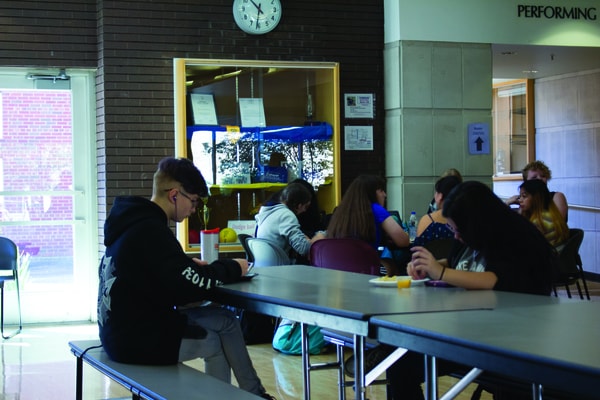Sitting Isolated in the Lunchroom
Eating alone is much more common than Sequoits think, but it is also an easy problem to solve.

The cafeteria: the most typical high school setting. Pizza that drips with grease makes its appearance as the scent lingers around the room; chit-chat and gossip clash against each other as they bounce off the walls and the lunch line seems to never end. Looking around, guys wearing their last names and school colors all sit at one table, the girls with winged eyeliner, lipstick and short skirts sit at another and the chess team is strategizing at the table in the corner. So, where does that leave room for everyone else?
Most people say that if they saw someone sitting alone they would take the time to go over and sit with the person; however, according to the Antioch Community High School users of Twitter, only 57 percent of the 68 responses claimed they would accompany the lonely individual. Sitting alone doesn’t always have to be negatively connoted, as there are other reasons why a person may wish to eat alone during lunchtime. Some of these reasons include having an abundant amount of homework that is due later that day, needing time away from others or simply not liking the company of the people around them.
“It could just be that they’re taking away time from others,” senior Teagan Ames said. “I know that I don’t always like others, and some people don’t either. [Sitting alone] could be a sign to stay away for a bit because they need their space.”
Now, that leaves one question: when is the right time to approach someone sitting alone? Body language plays a very important role with identifying someone who is secretly calling for help and someone who is choosing to be isolated from others. For example, having earbuds in while doing homework could be a sign that the individual doesn’t want to be bothered because their attention is elsewhere. On the other hand, a student that has their head down and appears to be invested in their lunch might need a companion for the hour.
Approaching a student eating alone may put someone outside of their comfort zone; however, going those few extra steps and a simple, “Hey, can I sit with you?” allows the cafeteria to be a little more comforting. There are many ways to go about the initial approach, including security guard Fontaine Coleman’s, who has his own style of making distant teenagers feel welcomed.
“Me, being a people’s person, I would probably go up to them and see what’s going on [and] say hi,” Coleman said. “If I didn’t know them, [then I’d] introduce myself and would probably invite them to sit with me, even if I was in a group of people.¨
Coleman observes the students in the ACHS commons during lunch hours, making the environment more laid back and relaxed by initiating small talk with students and cracking jokes. Despite these efforts, teens continue to find themselves alone between the hours of 10 a.m. and 1 p.m. Is eating isolated inevitable within the generations to come, or can the school find a way to accept everyone?
One way kids can create unification in the lunchroom is if they participate in more school activities and get involved, whether it means joining the Spanish club or finding themselves at the lively football games on Friday nights. Being apart of these functions allows connections to form between other students, with some even leading to friendships. This lets someone recognize a person they saw at the game or club meeting and hopefully find a spot next to them at the lunch table.
Including others in daily activities might make the environment seem more welcoming and friendly. For example, offer if anyone wants the last Oreo in the package or set someone up to have a conversation. Asking someone how their day is going or what they’ve been up to can be enough chit-chat to brighten a person’s day.
These two ways to go about change are simple yet effective; however, not everyone will recognize the faces around them. It is true that majority of students grow up together throughout childhood due to mutual elementary schools or sports teams, but what about those who are new to the game? The majority of the time, the new kids are the ones without company, which gives an individual a better excuse to include them. A new student might be seeking someone to take them under their wing until they get themselves situated at school with friends and classes.
Take this opportunity and make the most of it because one day that person will never forget the time they made a new friend, which isn’t always easy in high school due to factors such as drama.
“People that have lived here for a while have all grown up together, and so they haven’t had an opportunity to experience change [because] they aren’t used to that,” Ames said. “Because I’m new here, not many people have came up and talked to me, so it’s like, ‘Are they judging me for being a new student or because of who I am?’”
Some people might dread lunch hour. It could be distracting noise that keeps one from finishing their homework, the food with a scent so strong it makes its way down the hall or the largest predicament possible: not having a guaranteed place to sit. The unknown is one of the greatest fears of mankind, which would explain why not knowing where to sit in the lunchroom is a common fear of a high school student, especially on the first day of school. With this information in mind, why not make the cafeteria an overall better place by including those who sit alone? In the end, it never hurts to ask.
There is no flaw, no fault, no shame in sitting alone if that is how someone spends their lunch hour, intentionally or not. The place where an individual sits does not have to determine their social status in the school. Fitting in comes with finding the right people to be surrounded by and trusting the process.
“You don’t have to be alone,“ Ames said. “You can always be yourself around people. Just be you and let them accept you. Don’t let people stop you from what you want to do and how you want to be.”
Never be afraid to reach out to someone new because it can be the littlest reminder that loneliness doesn’t have to be experienced in the lunchroom. Ironically enough, lunch is the one time in school that students can openly sit by whoever they want. Instead of promoting diversity, students can take advantage of being together and branch out in order to establish a more welcoming, positive environment for everyone.


